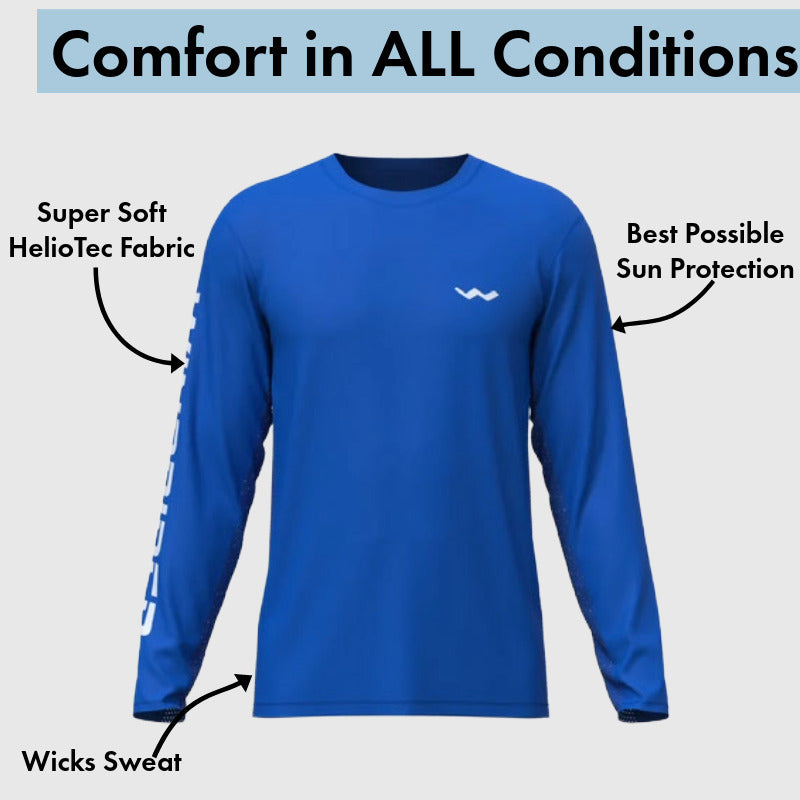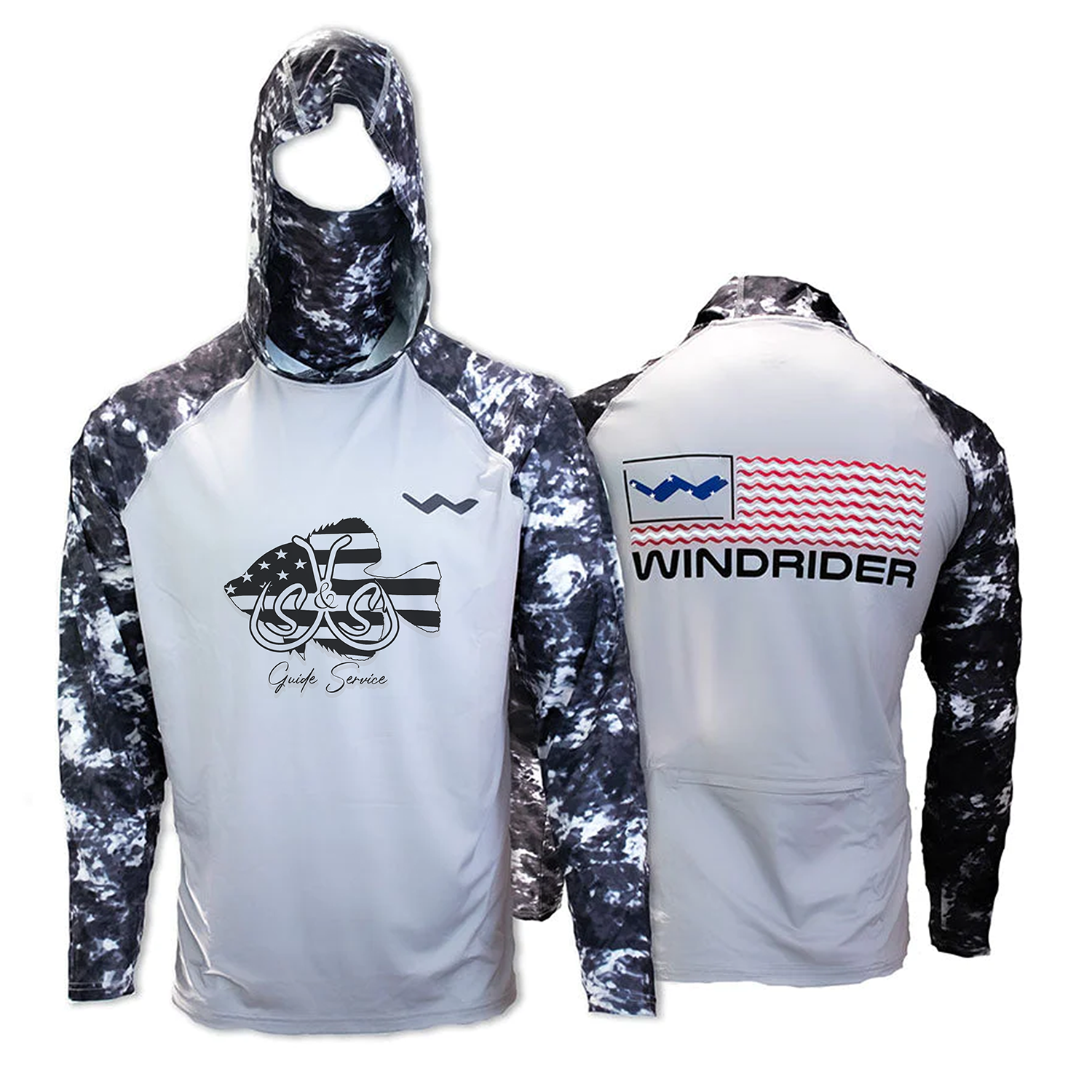The Brutal Reality: Striper Fishing Tests the Angler
Striped bass fishing culture prizes endurance. The fish never stick to schedules—you fish whenever they're on the move, regardless of conditions. A serious striper session typically starts before sunrise and runs through several tidal phases, often stretching into 10-14 hour marathons with only brief breaks.
These marathon sessions unfold in the most exposed settings imaginable. Beach fishing gives you no natural shade. You're standing on light-colored sand that bounces back 15-25% of UV radiation, so sun assaults you from below as well as directly overhead. Ocean spray leaves a film on clothing, and intermittent waves rush up, soaking you from waist down and often splashing high enough to drench your shirt.
Jetty fishing presents similar challenges but with added complications. Rocky jetties absorb sunlight and then radiate it, so surfaces can run 15-20°F hotter than surrounding air. As you're climbing, scrambling, and trying to keep balance on precarious ledges while casting, a stray hat or other piece of gear can be swept away permanently. A quality fishing shirt with built-in protection eliminates need to rely on accessories that might be lost.
The Spring-and-Fall Striper Run Challenge
Prime striped bass fishing aligns with spring and autumn migrations as fish wind their way along the Atlantic shoreline chasing bait. Those periods, however, bring deceptive sun that often catches even veteran anglers off guard.
Spring striper fishing generally peaks from April through June, though exact timing shifts with latitude. Air temperatures usually sit between 55°F and 75°F—comfortable enough for sleeves, yet UV Index is already edging toward summer intensity. That mix of cool weather and strong sun often lures anglers onto water all day, only noticing sun's damage when evening arrives.
When striper run peaks in spring and fall, UV Index routinely climbs into the 7-9 range—high to very high—so exposed skin can begin to burn after just 20-30 minutes of sun. A 10-hour outing on water without protection can deliver roughly 20-30 times the minimum dose needed to cause burn, leading to severe painful injuries and long-term skin damage.
Seasoned striper guides keep long-sleeve fishing shirts on throughout the season, even when air feels cool. They've learned that UV strength is dictated by sun's angle and prevailing atmospheric conditions, not by how warm or cold it feels.
The Casting Motion Required for Striper Fishing

Surf casting for stripers is essentially a marathon of overhead throws with rod and sizable lure or bait rig. A typical outing clocks in 200-400 full casts, each demanding full shoulder extension and rotation. Any restriction in clothing curtails casting distance, blunts accuracy, and eventually drives shoulder into fatigue or injury.
The Helios Long Sleeve Sun Shirt sports relaxed athletic cut with extra material over shoulders and chest, purposely engineered for casting. That added fabric gives 3-4 inches of extra range of motion, far cry from tight-fitting "performance" shirts that can restrict movement.
Four-way stretch in fabric is game-changer for casting sessions. As material yields to your casting motion, it retains shape memory and snaps back instead of staying misshapen. After hundreds of casts, shirt still fits right and moves with your body as naturally as ever.
Browse our shop all rain gear for more options.
Durability in Harsh Saltwater Conditions
Targeting striped bass throws gear into gauntlet of saltwater, rock scrapes, and mechanical strain of days on water. Low-grade fishing shirts usually quit after 20-30 days with seams popping, material breaking down, and salt stains that won't fade.
Designed for serious anglers, technical fishing shirts use flatlock seams that spread stress over broader swath of fabric instead of pinching it at single stitch line. Those seams sit flush against skin, preventing chafing even after marathon days of casting, hauling gear, and moving between boats or beach.
The polyester-nylon blend seems to shrug off salt damage for the long haul. In contrast, cotton gives way—its fibers degrade as salt crystals accumulate—while synthetic fibers hold their shape even after countless saltwater outings. A swift rinse with fresh water right after fishing washes away salt before it can settle or make fabric feel stiff.
Guides who handle 100-150 striper charters yearly report that durable technical fishing shirts typically endure 2-3 full seasons—about 200-450 days on water—before needing replacement. With price tag of $60-80 per shirt, cost works out to roughly $0.15-0.30 for each fishing day, far more economical option than swapping out cheap cotton shirts monthly.
Temperature Regulation During Variable Conditions
East Coast striper fishing involves dramatic temperature swings within single fishing sessions. Dawn launches often occur in 50-60°F conditions with wind. By midday, temperatures climb to 75-85°F in direct sun. Evening fishing might cool back down to 60°F.
Quality fishing shirts preserve comfort across the sweep of temperatures by deftly managing moisture. In cool moments, fabric cradles narrow film of warm air against skin. As you heat up and break a sweat, wicking action drags perspiration off your body, allowing it to evaporate and bring cooling relief. The same shirt that felt perfectly comfortable at 55°F stays just as comfortable at 85°F.
Because it handles temperature shifts on its own, you don't have to keep swapping outfits during marathon sessions; your gear stays tidy and you can zero in on fishing instead of wardrobe.
Color Selection for Striper Fishing

Color choice impacts both comfort and potentially fishing success. Light colors reflect solar radiation rather than absorbing it, maintaining surface temperatures 8-12°F cooler than dark alternatives under direct sun.
However, some striper fishermen believe bright or unnatural colors spook fish, particularly in clear water conditions when fishing shallow beaches or flats. While striped bass are far less spooky than trout or bonefish, subtle colors (light blue, gray, tan) provide psychological confidence without sacrificing cooling benefits of light-colored fabrics.
For safety during boat fishing, especially in crowded areas or during low-light conditions, visibility matters. Some anglers keep bright yellow or orange long-sleeve shirt specifically for boat fishing where other vessels need to see them clearly.

